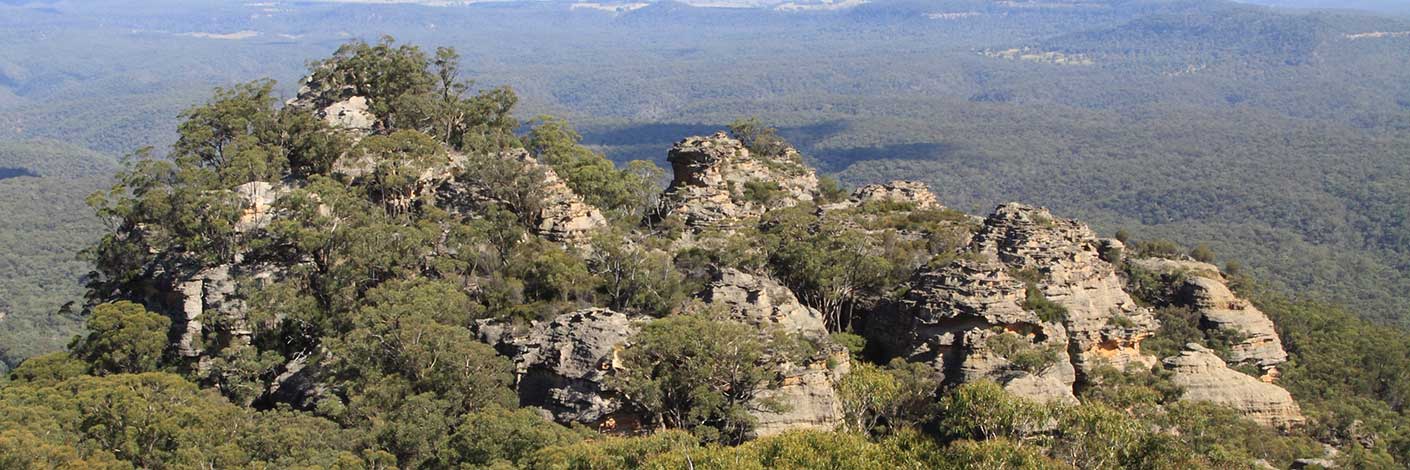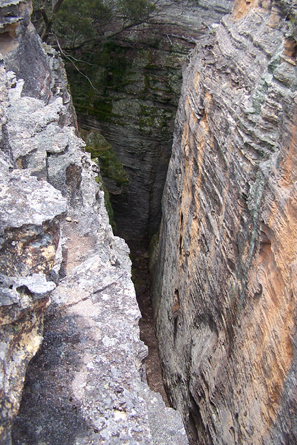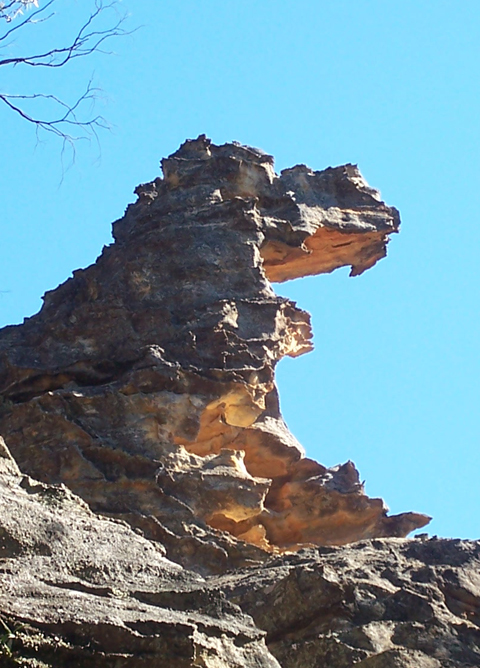Bush Explorers Encyclopaedia
Desperado Walls
Refers to the cliff line on the south western side of Mystery Mountain. Name recorded with map in Taylor, Pete. The Wolgan Valley A Rockclimber's Guide, 1st ed; 1974, p. 17. The first climbers in this area were Roland Pauligk and Tony Nemec in January 1975.
Devils Pinch *
Is a steep section of land close to and on the south bank of the Wolgan River, located 4.6km downstream from Newnes and 5.6km upstream from the Wolgan River and Rocky Creek junction. This point also marks the eastern end point of the Wolgan Valley. Devils Pinch was a descriptive name for the notorious narrowing of the valley which made travelling through the area difficult. It refers to the narrow tight squeeze for the bridle track between the river and high ground. The Parish Map of Barton, County of Cook, 1st edition, 1884 shows a bridle track along the Wolgan River from present day Newnes to the junction of Annie Rowan Creek and Wolgan River. Midway along this track, the Parish Map shows the name, The Devils Pinch. Shown on Mount Morgan Topo Map, GR 470 265, but correct location is GR 463 262.
Devils Pinch Canyon
Devils Throat
So named as the water rushing down Camp Creek enters a circular, 2 to 4m diameter shaft of about 15m in height and pours out at the base via horizontal slot hole in the rock, before cascading down another 15m drop. It is as if the devil's head is upside down and water pours down its throat and out of its mouth. Named by Michael Keats on a Bush Club walk, 22nd March 2007. Devils Throat is also the bottom part of Alcatraz Canyon.
Devils Throat Pass
Gives an easy access in a cliff lined area from the western end of Fire Trail No. 1 via Glowworm Tunnel Road and Carne Creek. So named by Brian Fox and Michael Keats on a Bush Club walk, 10th April 2015 as it gives the easiest and quickest access to Devils Throat within Camp Creek.
Diagonal Caves
Are located above Adrenalin Creek. They were named by Yuri Bolotin during a Bush Club walk in this area, 8th April 2013. These caves are on two distinct levels and are slightly offset from one another. It is not possible without some significant risk to climb from the upper to the lower cave. Both caves have a single curved overhang which is over 100m.
Diamond Cavern
Is located on the western side of Adrenalin Creek and 500m east of Fire Trail No. 6 off Sunnyside Ridge Road. Named by Chris Sterling and described on Michael Keats walk report on the 27th November 2012 as,"we entered a huge and cavernous eroded area. Slot is not quite the right word. A cavern is best description. The mouth was tapered from both the top and bottom giving a rough pinched diamond shape to the aperture. The cavern widens inside and the floor rises rapidly towards the back, some 40m in from the opening."
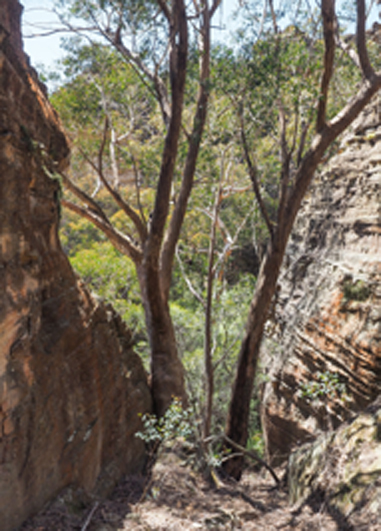
Diamond Ramp
Is located within the Eldorado Slots above Eldorado Walls, 1.6km due south of the old Newnes Hotel. This ramp led to the top of an extremely eroded pagoda, with three evenly spaced ravine/slots of great dimensions stretched out below at 90 degree angles to each other. Jointly named by Yuri Bolotin, Michael Keats and Brian Fox on a Bush Club walk, 10th October 2016 in keeping with the Eldorado theme, plus a Diamond Python was photographed at the base of the ramp.
Dicksonia Forest Ravine
Is one of the oldest and finest Dicksonia antarctica Tree Fern forests a person is ever likely to come across. Located within a northern tributary of Dingo Creek, 1.4km south west of Deep Pass. This name was coinedby David Dash and Michael Keats on a Bush Club walk, 16th November 2012.
Dingo Creek *
Rises on Waratah Ridge, north east side of Glowworm Tunnel Road and Waratah Ridge Road. It is about 17km in length and flows north and east into Bungleboori Creek. Name assigned by GNB, Government Gazette, 29th September 2006. Originally, Dingo Creek only referred to the first 4km of the creek from its headwaters; the eastern section of this creek was known as the North Branch Bungleboori Creek.
Dingo Creek Falls
Located on Dingo Creek, 940m south east of Cockatoo Hill. These falls have a drop of about 10m into a small rocky pool with a depth of 1.5m. Named by Brian Fox 28th November 2014 on a Bush Club walk.
Dingo Defile
Is located 800m south east of Eastern Boundary Road and Deep Pass Trail. This narrow defile between two large gullies gives access from a northern tributary cliff line towards Dingo Creek. Named by Brian Fox on a Bush Club walk, 28th November 2014. The vertical difference is 65m. A squeeze midway via a tunnel opens into a narrow, fern filled defile.
Dingos Lair
Is located 800m south east of Eastern Boundary Road and Deep Pass Trail. Named by Michael Keats on a Bush Club walk, 28th November 2014. "U" shaped over hang in which the western wall is more than 105m in length. The back wall about 50m and the eastern wall 50m. In the centre at the northern end a finely divided waterfall some 15m high cascades onto a rocky platform. It appears to be a permanent water source.
Dinner Gully *
Is a water courserising about 7km west, south west of Rock Hill. It flows for about 2km generally north, north east into Budgary Creek. Mount Cameron Trail passes midway along Dinner Gully. Name gazetted on 30th May 1975 as Dinner Gully. Previous name Dinner Creek. Lt. Col. Hugh Powell Gough Clews, known as "The Major" (1890-1980), Australian Survey Corps, named Dinner Creek after the place where they had lunch (dinner). Ref: Kameruka Magazine, Vol: 16; No. 2, July 1978. Note: Clews chapter, The Bad Bit across the River, records,"Lunch at the appropriately named Dinner Creek." The bridle track to Mount Cameron was in use from 1903 and Clews (in the 1930s) most likely was just referring to the already local name.
Dinosaur Slot
During a walk on 18 July 2020, after spending some time at the lookout on the edge of the Valley of the Dinosaurs, we did not return to the road but walked south, following the rim of the valley. At GR 2529 3201, 996 m, we located a stunning slot, 50 m long and only about half a metre wide, that ends up on the valley floor, at GR 2536 3203, 980 m. Yuri Bolotin named this dramatic alternative entry to the valley, Dinosaur Slot.
Discontiguous Fern Slot
Is located 900m north east of Invincible Trig Station. Named by Michael Keats on a Bush Club walk, 30th August 2103. This most unusual slot and waterfall combination has two breaks and morphs into a contorted, sculptured canyon like form. It then reverts to a fern backed waterfall before again becoming a sculptured form, terminating in a flat and usually dry quartz gravel terrace.
Divine Descent
Is an access point from the top to the base of the cliff line on the eastern side of Carne Creek and on the southern side of Nobles Canyon. It cannot legitimately be called a "pass" as only a few could ever do it without a tape or rope, and a "pass" should be negotiable in both directions without aids. Named by Michael Keats on a Bush Club walk, 19th May 2014.
Dobbs Drift
Originally referred to the State Mine entry but now locally refers to the steep section of road on State Mine Gully Road, 1.8km north of the railway workshops. The gully in which the State Mine was located was locally known by a number of names - Steak Knife Gully, Permafrost Gully, Dobbs Drift and The Drift. Dobbs Drift is located 1.5km north of State Mine Museum referred to in the entry under the State Mine. A drift is an incline access into a mine, i.e. not vertical or horizontal. The mine entrance, built in 1948, was named after John Phillip (Jack) Dobbs who was the State Mine Miners Federation Lodge Secretary. Ref: Lithgow Mercury, 12th June 2001, 3rd January 2002 and Stephen Imrie's correspondence, 5th January 2010.
Dobbs Drift Lookout
Is located off State Mine Gully Road, 2.1km north of the railway museum, State Mine Gully, Lithgow. This unfenced lookout gives easy accessible views back towards Lithgow and the surrounding rock pagodas.
Doctors Gap *
Is a suburb on the eastern side of Lithgow. The original track cut by Thomas Brown in 1834 came via Bells Line of Road and southern end of the old landing strip off Scenic Hill. (midway along the old track). Most likely named after Dr Walter Fawkes Mackenzie, (died 1886). He owned land covering 400ha between Lithgow and Hartley Valley. He was a medical doctor, Ref: SMH 9th August 1872, p. 1. He and his brother John held coal leases in this region. Ref: Carne, J F. The Kerosene Shale Deposits of NSW, 1903, p. 244.
Dogs Rug
Is located 200m below Dingo Defile and eastern side of a small tributary. A scramble up a slot leads to a rumpled platform below a higher cliff line. Named by Michael Keats on a Bush Club walk, 28th November 2014 in keeping with the Dingo theme of the area.
Dog Trap Creek *
Is a non perennial stream rising about 4km south by west of Genowlan Mountain. It flows generally east for about 6km into Coco Creek. All of Dog Trap Creek tributaries are on the northern side of Glen Davis Road. Most likely, the name would have originated from the use of traps to catch Dingos in this area.
Dome Cave
Named so because its domed ceiling is naturally decorated by a series of almost perfect concentric circles, as successive layers of ironstone banded sandstone have been uniformly removed in a circular manner. The floor is loose sand and is at an angle of almost 45 degrees. The dimensions are grand, 18m across the front, 16m from the drip line to the back wall and 12m high, also measured at the drip line. Named by Yuri Bolotin on a Bush Club walk, 16th May 2013.
Dome of St Peters
Is an unusual pagoda 2.4km due south of the junction of Two Trees Road and Waratah Ridge Road. It contains an arch of fine proportions with the sunlight reflecting on a small, centrally disposed natural plinth within, like a flaming votive symbol, and secondly, when you enter the arch, it opens out as a great internal dome. Michael Keats and Brian Fox on a Bush Club walk, 21st May 2012, named this the Dome of St Peters, continuating the heavenly theme of features within this locality. The dimensions are: height 4m, width 6m and arch width 3m. The dome interior is larger, nearly 5m in diameter, as it extends beyond the arch.
Donkey Mountain *
Is a dissected mesa 8km south, south west of Newnes. This large, isolated mountain, 950m in height, is 350m above Wolgan Road. The mesa has at its southern end Mount Wolgan. Extensive views over the greater part of the Wolgan Valley can be seen from the top of this mountain. A note in Surveyor Robert Hoddle's diary, dated 12th November 1825, "Mr Walker J.P. and party in that quarter (Capertee area) A she ass foaled: being the first bred in theColony."Ref: Colville, Berres Hoddle. Robert Hoddle Pioneer Surveyor 1794-1881, 2004, p. 92. Annabella Boswell's Journal, 1839, records, that James Walker (who owned the outstation Wolgan) had quite a few donkeys. The mountain was first shown (but with no name) on the Survey Plan B4.691r, dated 3rd January 1831 Originally spelt on the early parish maps as The Donkey Mountain, for example, Parish of Wolgan, 1884. It was not until the recent parish maps of the early 1960s that the word "The" was dropped. Locals referred to the mesa as Big Donkey and Little Donkey (Little Donkey is Mount Wolgan). Ref: Joe Bird, oral history to Brian Fox, 15th June 2009. Joe also spoke to me about a path cut into the Wolgan Valley, called the Donkey Steps. Joe's great, great grandfather, Edward (Ned) Murray (1791-1862), was one of the earliest farmers in the Wolgan (he worked for the property owner, James Walker from 1824) and he had a donkey that he called Neddy. Thomas Archer records in his diary on the 17th June 1866, "Mule arrived last night from Wolgan." Ref: Morgan, MacLeod. A short history of the Wolgan Valley, 1959. RAHS Journal, Vol. 45, Pt. 2, p. 88. Geoff Fox, a bushwalker with The Bush Club, has explored, mapped and named many of the individual features within Donkey Mountain.
North East Maze section: Grand Entrance, The Freeway, Kents Crevasse, Two Storey Cave, The Green Room, Fairy Cave, Eagle Rock, Eagle Nest, The Grand Hall, Fig Trees Green Room Portal, Jenny Craig, QANTAS Drop, Fire Ramp, Wide Ramp, Scrubby Ramp, Lighthouse, Arrow, Gum Tree Room, Treeway, Cowpasture, Donkey Canyon, High Cave, Low Cave, Mossy Rocks, Long Passage, Too Tight Crevasse, Wolgan Window.
Middle Donkey Mountain section: Window,Titanic Canyon, Fern Gully, Eastern Lookout, Tayan View, Kents Ascent, Sticky Ramp, Port Canyon and Terrace Canyon.
The South West End: Sun Ledge, The Columns, Python Point, Top Slot, Fence, and The Stile.
Note: Donkey Mountain is a very fragile environment. Please help protect it by refraining from camping on the mountain and by only using fuel stoves; no lighting of wood fires.Donkey Steps
This pathway was on the eastern side of the present day Wolgan Road near Wolgan Gap; it was locally named the Donkey Steps. This area is currently used as access for the telephone line into the Wolgan Valley. The road down this steep section was surveyed on 3rd March 1866, but the present road down Wolgan Gap was found to be a better alternative. Ref: Road Plan R587.1603r. Referred to as the original access into the Wolgan, it was here that the first cattle were brought into the valley. Ref: Joe Bird, whose great, great grandfather lived and worked in the Wolgan Valley, oral account to Brian Fox, 17th June 2009. Also; Ref: Morgan, MacLeod. A short history of the Wolgan Valley, 1959. RAHS Journal, Vol. 45, Pt. 2,p. 93. Anything too large was lowered directly over the cliffs on rope. It was not until 1897 that the present Wolgan Road was constructed. Ref: Wolgan Valley Homestead Complex - Conservation Management Plan, prepared by Conybeare Morrison International, 2006. The Survey Plan C2323-1507 shows "permanent spring" near the top of the Donkey Steps.
Donkey View Pass
Is a natural pass giving access through the cliffs to the top of a long, thin peninsula located at the northern extremity of Firetrail No. 7 off Sunnyside Ridge Road. Named by Michael Keats on his Bush Club walk, 28th October 2009.The choice of name was derived from the dominant view across the Wolgan Valley to Donkey Mountain.
Doom Caves
Double Decker Cave
Is located underneath the Wolgan Valley’s top cliff line, 2.3km north east of the propertyKoopartoo. This two storey overhang has dimensions of about 60m in length by 5m high by 10m wide. Named by Yuri Bolotin and Craig Flynn on a bushwalk on 30 September 2017.
Double Decker Gully
Is a useful way of route up some 190m from the Wolgan Valley that terminates at the spectacular Double Decker Cave. Named by Yuri Bolotin and Craig Flynn on a bushwalk, 30 September 2017.
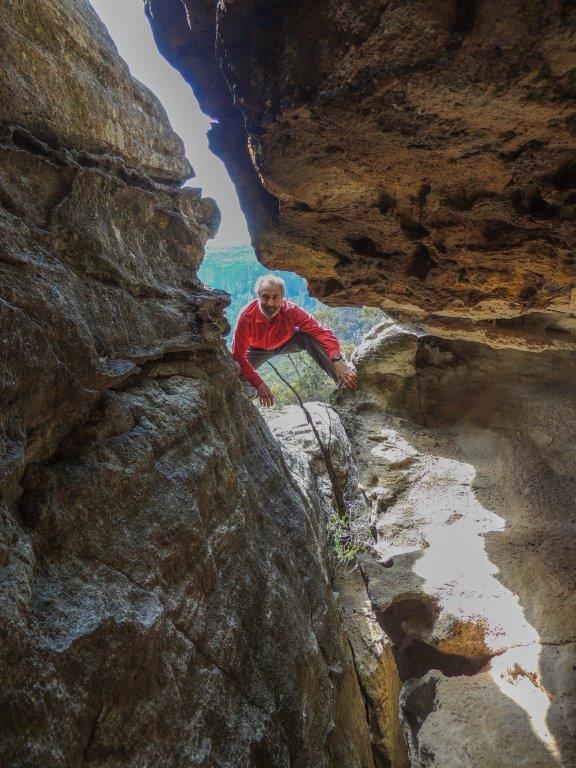
Double Decker Slot
Is located high above the western side of Genowlan Creek, 1.1km south, south east of Point Hatteras. This very narrow 50cm wide and 5m high slot extends for about 30m. Because of many chockstones, this slot also has a second storey passage that can be walked to the top of the slot, hence the name. Named by Brian Fox and Yuri Bolotin on a bushwalk of 2 August 2019.
Dragons Lair
Is a promising cluster of pagodas, photogenic and waiting to be explored, 400m south of Point Hatteras. Named by David Blackwell, November 1984. Ref: Correspondence with David Blackwell, 2nd May 2010.
Drum Rock
Is located on the edge of an overhang, on a northern side creek off Rocky Creek,1.5km north east of Mount Budgary. Named by Michael Keats on his Bush Club walk, 25th March 2009. This unusual rock, about 1m cube in size,reverberates when struck, producing a rhythmic, drum like sound.
Drury Cave
Is so named as this large overhang has the name, R Drury 1938, written in it on the back wall. In a visitor's book in an Aboriginal cave in this vicinity, there is an entry which reads, 'site was discovered in 1928 by Nelson Mason and Robert Drury'. Nelson's grandson related that they discovered this area while fox hunting, which they did regularly during those days, to sell the fox skins.
Duiwan
See Coxs River
This aboriginal name according to Helen Riley, Wiradjuri Elder and Sharon Riley, Wiradjuri representative means, Emu. Ref: Oral history 3rd May 2016.
Dulhuntys Creek *
Has its headwaters on the eastern side of the township of Portland. It flows in a generally northerly direction for over 16km to join Williwa Creek at GR 771172, which in turns flows into Jews Creek and the Turon River. The first land grant of Cullen Bullen, (2000ac), was taken up by Robert Venour Dulhunty. His brother, Lawrence Vance Dulhunty, also took a large grant of land nearby. For more information on the Dulhuntys, see Cullen Bullen entry.
Dulhuntys Hole
Now known as (see) Rowans Hole. This was the shortest route into and out of Capertee Valley. Note: Shown on the map Parish of Ben Bullen, 1885, as Dulhuntys Hole and the latter maps as Rowans Hole. See Cullen Bullen entry re the Dulhuntys.
Dumbano Creek *
Also see Suboir Canyon. A watercourse, about 14km long. It rises about 3.5km east of Bald Trig Station and generally flows north east into Bungleboori Creek. One of the first bush walking clubs to explore Dumbano Canyon was the Sydney University Bush Walkers. Early walkers from the SUBW were John Paynter and others, who on 24th - 26th December 1961 went as least as far as the upper and middle constrictions. Ref: www.subw.org.au/archives. The three Aboriginal named creeks in this area, Dumbano, Bungleboori and Yarramun, were most likely named by Major Clews when he surved this area in 1932 for the Wallerawang one inch to the mile Army Topo Map.
Dung Cave
Is a large sandstone overhang located at the junction of Camp Creek and a tributary that flows into Carne Creek. Named by Michael Keats on his Bush Club walk, 7th March 2007, because the old and odd shaped animal dung was found in this overhang.
Dwarf Casuarina Forest
Is located on the western slopes of Genowlan Mountain, 1.5km south of Genowlan Point. Ref: Correspondence with David Blackwell, 2nd May 2010, who records , "this is really just a default name, it being a most distinctive and beautiful pin cushion forest, waist high. The area is completely covered with Allocasuarina nana, with occasional, taller protruding Xanthorrhorea." Named c1984.
Eaglet Rock
Is located within the Mugii Murum-ban State Conservation Area on the western side of Mount Airly and below the feature known as Torbane Balcony. Named by Yuri Bolotin and Peter Medbury on a bushwalk 14 June 2021. Yuri recorded, "a giant rock sculpture that looked like an Eagle chick".
East Creek
Is a tributary of Carne Creek and has its headwaters between North Ridge Road and Camp Road, 2.7km north east of Bungleboori Camping Ground. It flows in a generally southerly direction for 5.7km to its junction with Carne Creek. 700m before this junction, Camp Creek flows into it from the east. Name recorded in the Proposed Birds Rock Colliery, Environmental Impact Assessment, December 1981, figure 3.
East Creek Falls
Located within the southern end of East Creek. The creek watershed is between North Ridge Road and Glowworm Tunnel Road, Newnes Plateau. The top bridal veil fall is over 30m, the lower fall about 20m. Connecting the two falls is a twisted hollow tubular section of about 4m. The bottom waterfall discharges into a glorious shallow pool. Named by Brian Fox and Michael Keats 30th March 2015.
East Creek Galleries
East Wolgan Swamp
Is located at the headwaters of the Wolgan River on the northern side of the road junctions, Blackfellows Hand Trail and Beecroft Firetrail. This swamp extends for 2km. The southern part was originally known as see Lightning Swamp.
Easy Glade Pass
Gives an easy grade access between the valleys of Little Capertee Creek and Canobla Creek. Named by Yuri Bolotin on a Bush Club walk, 20th April 2017. Yuri recorded,“Thinking about both coming up from Canobla Creek side and especially walking down into the Little Capertee Creek, this was one of the easiest and most pleasant passes in memory, so I called itEasy Glade Pass (if it sounds a little bit like ‘easy grade pass’, then I meant it this way).”
Echo Lookout
Is located 200m above and overlooking the Wolgan River, access 3km from Little Capertee Creek Camping Ground via the Pipeline Track. Named by Thomas Ebersoll, owner of the old Newnes Hotel and shown on his hand drawn map, The Newnes Area, 2005.
Edmund Cavern
Edmund Cavern is 100m further south of Edmund Falls within Edmund Gully. This cavern is a gaping fern filled cave inaccessible to walkers halfway up the cliff face. So named by Michael Keats and Brian Fox on a bush club walk, 25th May 2015. Joseph Edmund Carne (1855-1922) State Government Geologist for whom Carne Creek is named.
Edmund Falls
Located within Edmund Gully a cliff lined tributary of Carne Creek, which is on the southern side of Fire Trail No. 3, off Glowworm Tunnel Road, is a 30 plus metre waterfall, So named by Michael Keats and Brian Fox on a bush club walk, 25th May 2015. Joseph Edmund Carne (1855 -1922) State Government Geologist for whom Carne Creek is named.
Edmund Gully
Is a cliff lined tributary of Carne Creek, located on the southern side of Fire Trail No. 3, off Glowworm Tunnel Road. Within this gully is a 30 plus metre waterfall, Edmund Falls. Edmund Cavern is 100m further south, a gaping fern filled cave inaccessible to walkers halfway up the cliff face. So named by Michael Keats and Brian Fox on a bushclub walk, 25th May 2015. Joseph Edmund Carne (1855-1922) State Government Geologist for whom Carne Creek is named.
Edwins Bath
Is located above the cliff line 1.6km north, north west of the intersection of the Wolgan Road and the road to the Emirates resort. Edwin Barton (1833-1876) had married Georgina Lyon Wolgan Walker (1843-1906) in 1865. Their family were the earliest property owners in the Wolgan Valley. Edwins Bath is just one of many tributaries which runs into Barton Creek. The use of the word, ‘Bath’ describes a glorious one metre deep crystal clear pool enclosed in an ornate chamber of natural architectural splendour. Named by Michael Keats, Brian Fox and Yuri Bolotin on a Bush Club walk 30th August 2016.
Edwin Slot
Is located above the cliff line 1.5km north north west of the Wolgan Road and Emirates intersection. So named as it is the first name of Edwin Barton in keeping with the nearby Barton Slot and Barton Glen. Named on a Bush Club walk, 28th August 2015 by Brian Fox, Yuri Bolotin and Michael Keats. This slot is about 40m long, up to 30m high and varies in width from a very tight 30cm to 1m.
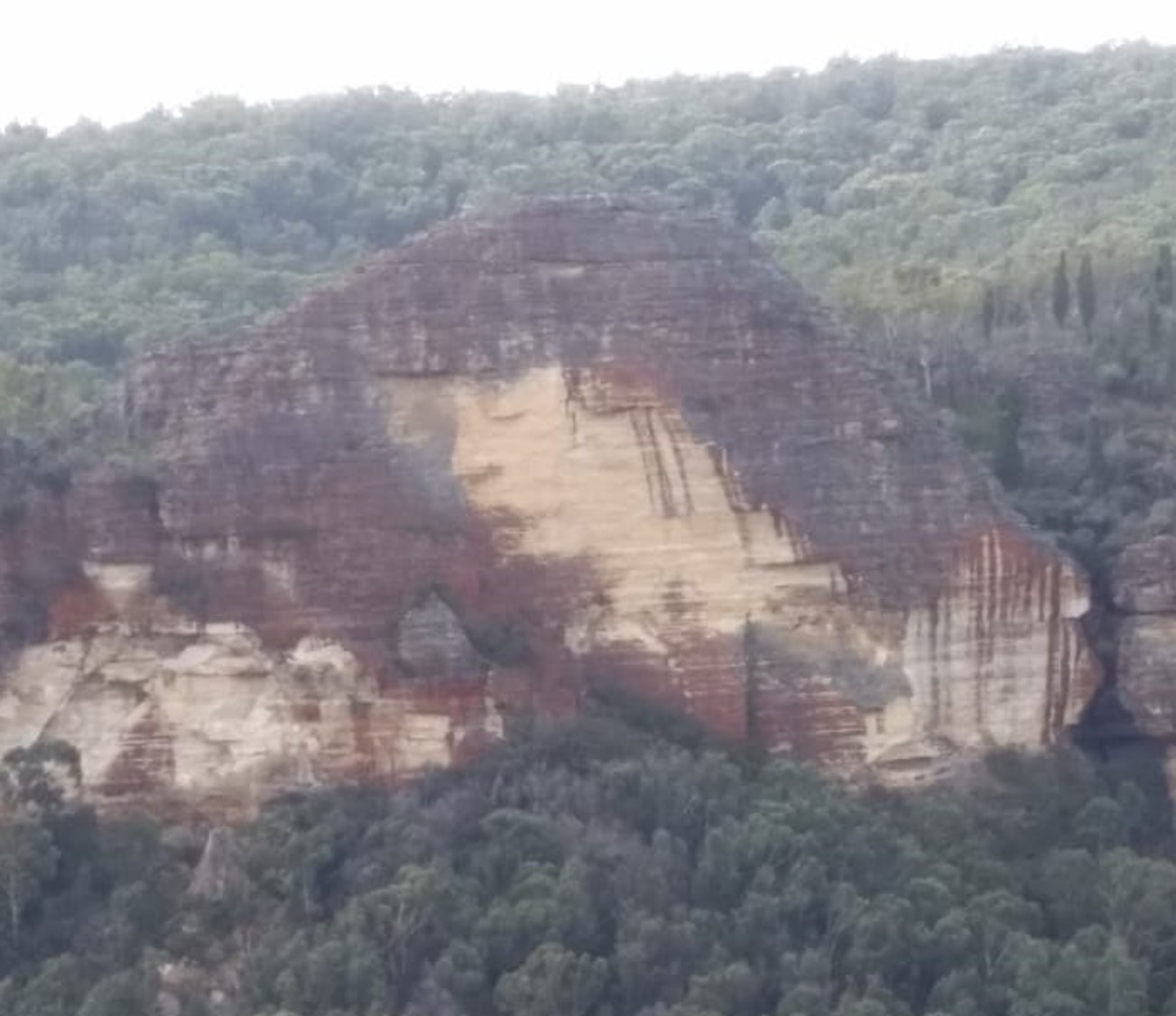
Egyptian Rock
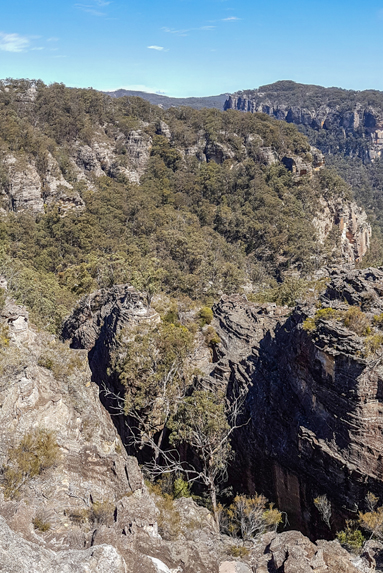
Eldorado Slots
Is the accumulative name to over 20 slots which dissect the Eldorado Walls. Located in a 400m wide semicircular gully above the first major cliff line 1.5km due south of the old Newnes Hotel. Jointly named by Yuri Bolotin, Michael Keats and Brian Fox on a Bush Club walk, 10th October 2016 in keeping with the Eldorado theme. Silver Slot and Diamond Ramp are two named slots in this complex.
Eldorado Traverse
Eldorado Walls
Refers to the bluff as seen to the south of the old Newnes Hotel. This high, cliff faced hill is above the junction of the Wolgan River and the Capertee Creek. Fabled El Dorado is associated with gold, and the sun shining on the walls gives this golden hue. Name recorded in Taylor, Pete. A Rockclimbers Guide to the Wolgan Valley, 1st ed; 1974, p. 137. Climbed from January 1975.
Elysium
Elysium is located within Wollemi National Park above the cliff line and about 1 km due west of the Zobels Gully and Wolgan River junction. This is a flat, almost square space, about 50 m by 50 m enclosed on three sides by very high walls formed by giant curved blocks of bare grey and black coloured sandstone. Enormous Tree Ferns, more than ten metres high, fill this space. Named by Yuri Bolotin on 20 November 2020. He described it as,“The light, the colours, the textures, the sounds were all divine and made it such a perfect, special place to wander in. Wow! I have called this exceptional corner of the Wollemi, Elysium, Paradise in Greek mythology, in keeping with the theme of this area.” This area is accessed via Elysium Slot.
Elysium Slot
Elysium Slot is located within Wollemi National Park above the cliff line and about 1 km due west of the Zobels Gully and Wolgan River junction. At the top it is only about 50 centimetres wide, with parallel walls over 10 metres high. It goes down at a sharp gradient, widening gradually to about three metres across, and finishes with a negotiable drop into a wider gully and a ledge in the left-hand wall. Named by Yuri Bolotin on 20 November 2020. He described it as,“It is a very impressive slot, measuring about 50 m in length and dropping 20 m below the cliff line.” This slot leads to Elysium.
Emirates One & Only Wolgan Valley Resort
Construction of the resort commenced 21st November 2007. The complex is an investment of more than $125 million plus which included major upgrades to fencing, power, roads and electricity infrastructure. The resort is the largest capital investment in the Wolgan Valley since the Newnes Industrial Complex was built a century earlier.
Endorphin Channel
Is a slot on the eastern side of Endorphin Gully, having a length of 60m and width varying from 50cm to 1m. It descends like a staircase through about 30m of vertical height. Named by Michael Keats on a Bush Club walk, 6th May 2013.
Endorphin Gully
Is located between Sunnyside Ridge, (Firetrail No. 7) and Adrenalin Head, (Firetrail No. 6). It rises on the spine of Sunnyside Ridge and flows north to join Carne Creek. Named by Michael Keats on a Bush Club walk, 6th May 2013.
Endorphin Point
Is a high viewing location with expansive views over the Wolgan Valley, including Donkey Mountain. So named by Michael Keats on a Bush Club walk, 20th June 2013, after the gully below, Endorphin Gully. Endorphin Point is shown as a spot height of 1006m.
Endorphin Slot
Is located 1.1km south, south west of the Wolgan Pinnacle on the western side of Endorphin Gully. This very narrow slot is just 30 to 40cm wide. Its smooth vertical walls are 20m in height, and it has a length of 30m which includes a right angled bend. Named by Brian Fox on a Bush Club walk, 20th June 2013.
Eskbank Track
Is a walking track between the southern end of Eskbank Street in Lithgow and Braceys Lookout in the Hassans Walls Reserve. The name "Eskbank" comes fromEskbank House , Lithgow. The track was reconstructed in 1998.
Ethereal Canyon
Is located 2km near due east of the intersection of Waratah Ridge Road and Two Trees Road, within Newnes State Forest. "Ethereal" means light, airy, heavenly or celestial. So named by Michael Keats on a Bush Club walk, 24th September 2012, after Rodney Nelson, a fellow bushwalker, captured on camera shafts of light entering this beautiful canyon.
Ethereal Falls
Exploded Pagoda
Plain of Shards is an area of rock formations located 400m north, north west of Mount Jamison and 700m south west of Wolgan Trig Station. Named by Rodney Falconer, who was one of the major players in the creation of the Gardens of Stone National Park, November 1984. Rodney named it after a sweeping expanse of bare rock, covered by the scattered remains of ironstone bands as if broken pottery was scattered across it. Other names recorded areThe Exploded Pagoda. Ref: Tom Brennan’s photo gallery, October 2010.Exploded Pagoda. Ref: David Noble’s blog, 9th July 2013. Ben Bullen Topo Map, GR 310 197.
Exploding Galaxies
Refers to the cliff line above the Wolgan River, opposite the Pipeline Track. Name recorded in Owens, George. New Rock climbs in the Blue Mountains, 1972.
Faberge Caves *
Faberge Gully
Faberge Gully is located below Faberge Caves which on the southern side of Mount Tricky, 1km above Little Capertee Creek Camping Ground, Newnes. Named by Yuri Bolotin, 2nd October 2015 the gully is an access down towards Cathedral Canyon above the Little Capertee Creek Camping Ground.
Fantasia Room
Is within the feature known as Mothers Arms on the eastern side of Genowlan Mountain, 1.2km south of Genowlan Point. This ‘room’ is accessed via beautiful dry overhang, 50m long and 3-4m high, with a flat floor covered with white powdery sand, which in turn leads to the bottom of a giant slot. This slot is likened to a room which continues for about 40m and terminates at a wall of ferns, pierced by a very narrow slot on the left hand side. Named by Yuri Bolotin and Brian Fox on a Bush Club walk on 22 December 2017 as the room is located next to Fantasia Traverse.
Fantasia Traverse
Is a mix of slots, canyons and cross junctions located on the eastern side of Genowlan Mountain, 1.3km south of Genowlan Point. It is part of Mothers Arms Pagodas. Named by Michael Keats on a Bush Club walk, 9th - 11th November 2010. So named due to the variety, beauty and challenging components of this section.
Farmers Creek *
Is a perennial stream rising 4.5km north of Clarence Railway Station. It flows generally south west for about 17.6km through city of Lithgow into Lake Lyell and the Coxs River. Surveyor General Thomas Mitchell recorded in his diary on the 2nd April 1835. Ref: Mitchell, Major Thomas. Expedition to the River Darling, 1835.
Fernbrook Creek
Has its headwaters at the southern junction of Fernbrook Ridge and Marrangaroo Ridge. It is non perennial and flows generally south for 2.7km to join Marrangaroo Creek. Named by Brian Fox, 29th March 2016. Fernbrook Fire Trail follows part of this creek system.
Fernbrook Fire Trail
Links Reserve Road, Marrangaroo to the Beecroft Firetrail. Named after Fernbrook Creek in which it follows.
Fernbrook Ridge
Trends generally south from Marrangaroo Ridge for 4km to above Marrangaroo Creek. Lithgow Topo Map. Named after Fernbrook Firetrail, which generally parallels this ridge in the gully to the west. Name recorded on Michael Keats bush walk, 30th April 2010.
Fern Cave
Is located on the eastern side of East Creek, and 150m south of East Creek Falls. This cave is approximately 30m wide, 15m deep and has a height of 20m. The cave has a section of flat and sloped floor. In one corner there is a large natural window through which the water of a creek falls. But the most striking feature of the cave is that all of its walls are thickly covered in luxuriant green ferns, Named by Yuri Bolotin, on a Bush Club walk, 25th January 2016.
Finger Pinnacle
So named as this 30m high and 1m wide slab of detached rock face has broken away like a finger of a hand. Located below the first cliff line 300m north of the western end of Nobles Canyon. Named by Brian Fox on a Bush Club walk, 19th May 2014.
Finnigans Lookout
Is recorded in the Lithgow Mercury, 26th August 1935, p. 6 as one of the pretty spots to be seen along the top of Hassans Walls, Lithgow. Possibly the large rock at the end of Finnigans Point, which can be seen from the Great Western Highway at the top of River Lett Hill.
Finnigans Point
At Hassans Walls, Lithgow is described in the Lithgow Mercury, 14th May 1915, p. 4 as “a bold high promontory jutting out into the Hartley Valley.” Hartley Topo Map, GR 369 887.Finnigans Creek* GR 363 879 to 370 848 is a partly perennial creek that flows south into River Lett, 1.5km north east of Hartley and that was recorded in the Singleton Argus, 30th January 1926, p. 5. Finnigans Point can be viewed from the boardwalk at Padleys Pedestal Trig. Named after the Finigan family (note correct spelling) who lived in Hartley between the years 1840s to 1870s.
Finnigans Spur
Extends from Hartley Trig, off Hassans Walls Road in a generally southerly direction for 700m to Finnigans Point. The last 100m contains a dissected rocky outcrop. So named by Brian Fox and Keith Painter on the 6th September 2016 while investigating historical features in this area of Hassans Walls.
Firebird Rocks
Is a rocky ridge and cluster of incredible formations, stylised sculptures of birds as well as mythological creatures. Located on the western most pagoda above and on the eastern side of Baal Bone Gap, and 800m west, south west of Mount McLean. Named by Michael Keats on a Bush Club walk, 29th July 2013, as it reminded him of the fiery, phantasmagorical sounds and imagery of Russian composer Igor Stravinsky's Firebird Suite.
Firebox Ridge
Extends from Girdwood Ridge at the barrier between Newnes State Forest and Blue Mountains National Park in a generally north east direction for about 6km. Name coined by Wilf Hilder in 1972 to reflect the historical usage of the Wolgan Valley Railway.
Firecat Walls
Refers to the cliff line on the south western side of Sunnyside Ridge Road. This cliff line was named by Joe Friend and climbed from early 1972. Ref: Taylor, Pete. A Rockclimbers Guide to the Wolgan Valley, 1st ed; 1974, p. 13.
Firefly Canyon
This canyon was found by David Noble and Tom Williams in 1977 on a Springwood Bushwalking trip, they had noticed fireflies when they camped above the canyon. This canyon contains four or five short abseils. Reference: Jamieson, Rick. Canyons near Sydney, 1993, p. 40.
Firefly Creek
Firefly Creek has its headwaters on the western side of Island Mountain, 2.8km south east of Newnes. It flows in a generally north east direction for 2.9km to its junction with the Wolgan River. Within Firefly Creek is the canyon known as Firefly Canyon. This canyon was found by David Noble and Tom Williams in 1977 on a Springwood Bushwalking trip; they had noticed fireflies when they camped above the canyon. This canyon contains four or five short abseils. Reference: Jamieson, Rick. Canyons near Sydney, 1993, p. 40.
Firefly Point
Firefly Point overlooks the Wolgan River and Firefly Creek and Canyon which is 300m below. This point of land is on a the eastern end of a small plateau which has on the north side the cliff line known as the Exploding Galaxies above the Wolgan River. The southern side of the plateau is Firefly Creek and Firefly Canyon. Extensive views of the Wolgan Valley below. Named by Yuri Bolotin on a Bush Club walk 1st July 2016.
First Lookout
Is located at Hassans Walls, Lithgow above the eastern side of Rutherford Glen. So named as it was the first lookout when coming via the original track from Lithgow. Old graffiti engraved below this lookout records the name, H Watkins 1936. Ref: Lithgow Mercury, 25th March 1912, p. 2.
Flat Bottom Creek
Has its headwaters between Fire Trails No. 7 and 8 off Sunnyside Ridge Road.This creek flows generally north for 7km to its junction with the Wolgan River.Named by Michael Keats on a Bush Club walk, 18th July 2007. A motor bike trail crosses the headwaters of this creek at GR 360 118.
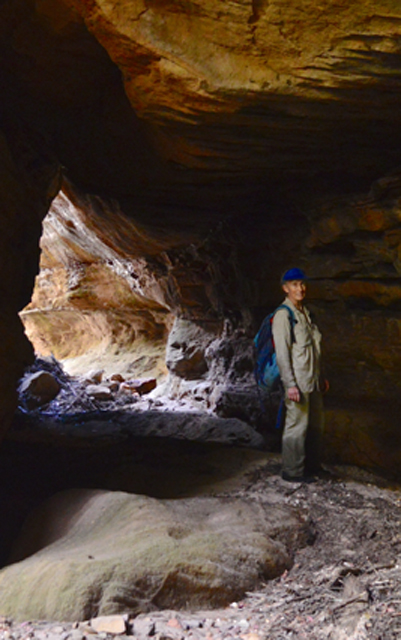
Flat Bottom Creek Tunnels
Are located on Flat Bottom Creek just before this creek plunges over the cliff line. Named by Michael Keats on a Bush Club walk, 22nd November 2013.
